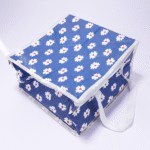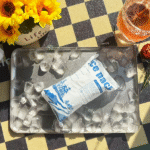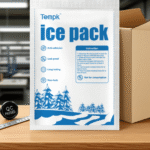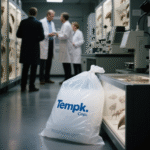Kemasan Es Kering Paket Es Kering: Apa yang Berfungsi 2025?
Menggunakan kemasan es kering paket es kering menjaga barang beku tetap padat dengan benar melalui penundaan dan penyimpanan depot di dunia nyata. Panduan ini memberi Anda aturan ukuran yang telah teruji di lapangan, SOP pengepakan, Dan 2025 catatan kepatuhan yang dapat Anda terapkan hari ini. Anda akan belajar cara memilih kotak yang tepat, di mana menempatkan bungkusan itu, dan berapa banyak yang harus digunakan untuk perlindungan 24–96 jam tanpa perlu menebak-nebak.
-
Bagaimana kemasan es kering paket es kering dibandingkan dengan gel dan PCM sepanjang musim
-
Cara memperkirakan kuantitas dengan cepat, metode berbasis jalur yang dapat Anda jalankan di atas kertas
-
Cara mengemas langkah demi langkah agar wastafel dingin dan hotspot hilang
-
Yang 2025 peraturan penting untuk kemasan es kering paket es kering melalui udara dan darat
-
Cara memangkas biaya per pesanan tanpa meningkatkan risiko klaim
-
Apa yang baru 2025: bahan, sensor, dan liner yang lebih ramah lingkungan
Apa itu kemasan es kering paket es kering, dan kapan Anda harus menggunakannya?
Jawaban cepat: Paket es kering kemasan es kering berarti memasangkan pengirim berventilasi terisolasi dengan kemasan CO₂ padat yang menyublim pada suhu −78,5°C untuk menahan muatan di bawah titik beku. Gunakan kapan pun produk Anda harus berada pada suhu ≤ −10°C, seperti es krim, daging, hidangan laut, Makanan penutup beku, atau spesimen laboratorium tertentu. Ini mengungguli paket gel untuk jalur beku karena sublimasi dapat menyerap panas seiring berjalannya waktu.
Mengapa itu berhasil: Bayangkan kotak Anda seperti termos dan kemasannya seperti mesin dingin. Saat CO₂ berubah dari padat menjadi gas, itu meminum panas, sementara isolasi memperlambat kehangatan luar. Jika Anda memuat paket ke atas, udara dingin secara alami meresap melalui muatan. Dengan kemasan es kering paket es kering, Anda mendapatkan waktu tunggu yang kuat per liter volume kotak—terutama berguna ketika rute kurir berubah atau hub mengalami kemacetan.
Jalur e-commerce yang dibekukan: kemasan es kering paket es kering vs gel
Intinya: Jika target dibekukan, kemasan es kering paket es kering menang dalam waktu tunggu per liter dan ketahanan terhadap siang hari yang panas. Gel unggul untuk +2 hingga jalur +8°C tetapi kesulitan untuk menjaga inti tetap benar-benar beku selama penundaan yang lama. Strategi campuran—es kering kecil ditambah gel yang melindungi makanan penutup yang hampir beku—dapat mengatasi kelebihan tersebut.
| Jenis Pengiriman | Suhu Target | Pilihan Pendinginan Terbaik | Apa artinya bagimu |
|---|---|---|---|
| Ice cream liter (musim panas) | ≤ −18 ° C. | Paket es kering kemasan es kering | Tekstur yang andal pada saat kedatangan; pengembalian dana yang lebih sedikit |
| Daging beku & hidangan laut | ≤ −12°C | Paket es kering kemasan es kering | Buffer yang lebih panjang untuk truk yang terlambat |
| Kit makan (dinginkan) | +2 hingga +8°C | Gel/PCM | Biaya lebih rendah, menghindari kerusakan akibat embun beku |
| Musim bahu | −5 hingga −15°C | Hibrida (CO₂ kecil + gel/PCM) | Mencegah pembekuan berlebih dan kerapuhan karton |
Tip dan saran praktis
-
Muat ulang terlebih dahulu: Tempat kemasan es kering paket es kering di atas produk sehingga dinginnya meresap secara alami.
-
Ventilasi tutupnya: Jangan pernah menyegel CO₂; gunakan tutup yang berventilasi atau celah untuk mengeluarkan gas.
-
Kecilkan kekosongan: Kencangkan sisipan sehingga kemasan “melihat” lebih sedikit udara kosong; ini memperlambat pemanasan.
-
Bungkus muatannya: Bungkus tipis untuk menjinakkan embun beku dan menjaga karton tetap bersih saat pengiriman.
-
Uji jalurnya: Satu data logger berbiaya rendah memvalidasi resep Anda sebelum Anda menskalakannya.
Kasus nyata: Merek makanan laut khusus beralih ke kemasan es kering paket es kering dengan top-loading dan ditambahkan a 15% penyangga untuk risiko akhir pekan. Tingkat klaim musim panas turun dari 6.4% ke 1.9% melintasi tiga zona dengan tetap menjaga tampilan karton dan pengalaman membuka kotak pelanggan.
Berapa banyak paket es kering kemasan es kering yang Anda perlukan?
Aturan lapangan yang dapat Anda percayai: Untuk rute hangat (20–30 ° C.), rencana 1.1–1,5kg es kering per 10L volume internal per 24 jam. Menggunakan 0.8–1.0kg untuk rute ringan (10–20 ° C.) Dan 1.5–1,9kg untuk rute panas (30–40°C). Mulailah dengan titik tengah, lalu tambahkan 10–20% penyangga untuk penundaan.
Metode lima langkah sederhana:
-
Ukur bagian dalam P × L × T (liter).
-
Pilih jalur rute Anda: lembut, hangat, atau panas.
-
Pilih tarif dari tabel di bawah ini.
-
Kalikan dengan hari (24 jam blok).
-
Kumpulkan dan dokumentasikan kilogram bersih es kering pada labelnya.
| Pita Rute | Profil Sekitar | kg per 10L selama 24 jam | Mengapa itu berhasil |
|---|---|---|---|
| Lembut | 10–20 ° C. | 0.8–1.0 | Beban panas yang lebih rendah; Sublimasi yang lebih lambat |
| Hangat | 20–30 ° C. | 1.1–1.5 | Rute e-com umum dan puncak sore hari |
| Panas | 30–40°C | 1.5–1.9 | Tinggal lama, persalinan di bawah sinar matahari, gelombang panas |
Contoh: Pengirim 24L, rute hangat, 48 jam → 1,3kg × (24/10) × 2 = 6.2 kg → tambahkan 15% = 7.1 kg total kemasan es kering paket es kering.
Penaksir cepat yang dapat Anda salin
Penyempurnaan tanpa perhitungan rumit
-
Karton rapuh? Kurangi kontak langsung: selipkan rak bergelombang tipis di antara bungkusan dan muatan.
-
Tepinya dicairkan terlebih dahulu? Tambahkan strip samping yang sempit kemasan es kering paket es kering untuk melindungi sudut.
-
Melebihi terlalu dingin? Coba hibrida: 70–85% es kering ditambah PCM kecil pada suhu −10°C untuk menghaluskan kondisi ekstrem.
Cara mengemas: SOP langkah demi langkah untuk pengemasan es kering paket es kering
Prinsip inti: Bangun inti yang terbungkus, CO₂ beban atas, tetap terbuka, dan mengunci kekosongan. Dokumentasikan kilogram bersih dan latih setiap pengemas dengan resep yang sama.
-
Pra-panggung kotaknya: Tambahkan bantalan bawah dan sisipan sudut untuk mengurangi pusaran udara.
-
Siapkan inti yang dibungkus: Tempatkan produk dalam bungkus pelindung tipis; menghilangkan udara berlebih.
-
Pas di bagian samping yang ketat: Masukkan bantalan samping agar bagian inti tidak bergetar.
-
Isi paketnya dari atas: Tempat kemasan es kering paket es kering di atas inti. Pecahkan balok besar menjadi potongan-potongan kecil untuk sublimasi yang merata.
-
Ventilasi dan label: Gunakan penutup yang berventilasi. Tandai “Es Kering (Dan 1845)” dan kilogram bersih.
-
Timbang dan catat: Catat berat kotornya, CO₂ bersih, dan ID pengemas di sistem Anda.
-
Tes goyang terakhir: Jika isinya bergerak, tambahkan dunnage ringan sampai pas.
Tata letak yang menghindari hotspot
-
Lapisan atas berjenjang: Dua lapisan tipis kemasan es kering paket es kering dengan celah kecil di antara pendinginan spread.
-
Perlindungan tepi: Potongan kecil di sepanjang sisi panjang melindungi sudut dari paku sekitar.
-
Keamanan penerima: Tambahkan catatan cerah “Ventilasi Sebelum Dibuka” di dalam tutupnya untuk membuka kotak dengan lebih aman.
Kepatuhan dan keamanan untuk kemasan es kering paket es kering
Hal-hal penting yang tidak boleh Anda lewatkan:
-
Penamaan yang tepat: “Es Kering (Dan 1845)" Dan berat bersih dalam kilogram pada paket.
-
Ventilasi: Jangan menyegel CO₂. Penutup berventilasi atau jalur gas yang dirancang adalah wajib.
-
Bahan yang kompatibel: Gunakan pelapis dan perekat yang tahan terhadap suhu −78.5°C.
-
Dokumentasi: Air waybill harus mencantumkan es kering dan kuantitasnya; operator mungkin memerlukan nomor kontak.
-
Pelatihan dan APD: Sarung tangan untuk menangani bungkusan, dan pelatihan kesadaran untuk pengepakan dan penerima.
Udara vs.. tanah: Pengiriman udara mengikuti peraturan maskapai penerbangan dan barang berbahaya IATA; pengiriman darat mengikuti aturan transportasi setempat (seperti DOT/PHMSA di AS.). Dalam praktiknya, sebagian besar kurir juga menerbitkan instruksi es kering mereka sendiri. Selaraskan SOP Anda dengan regulator dan operator.
Daftar periksa penanganan yang aman untuk tim Anda
-
CO₂ disimpan di tempat yang berventilasi, jangan pernah di ruangan tertutup atau bagasi mobil
-
Sarung tangan termal selalu ada di stasiun pengepakan
-
Tidak ada pendingin kedap udara; selalu melampiaskan tutupnya
-
Penerima diinstruksikan untuk membuka di ruang berventilasi dan menghindari kontak kulit langsung
-
Telepon darurat terlihat pada label untuk pertanyaan saat pengiriman
Pemodelan biaya: TCO kemasan es kering paket es kering vs alternatifnya
Apa yang harus dioptimalkan: Anda menyeimbangkan massa cairan pendingin, ukuran kotak, Kualitas isolasi, dan kerusakan. Paket es kering kemasan es kering sering kali mengurangi total biaya karena mengecilkan tingkat klaim dan memungkinkan lebih kecil, pengirim yang lebih ringan untuk waktu tunggu beku yang sama.
| Elemen Biaya | Kemasan Es Kering Paket Es Kering | Paket gel | PCM (−10 hingga −21°C) | Apa artinya bagimu |
|---|---|---|---|---|
| Biaya cairan pendingin per kapal | Sedang | Rendah–Sedang | Tinggi | CO₂ lebih murah per watt‑jam dibandingkan PCM dengan suhu sangat dingin |
| Ukuran kotak diperlukan | Lebih kecil | Lebih besar (untuk beku) | Sedang | Es kering meningkatkan watt‑jam per liter |
| Tingkat kerusakan/klaim | Rendah jika ukurannya pas | Lebih tinggi untuk beku | Sedang | Lebih sedikit pengembalian uang dan pengiriman ulang |
| Reusability | Pendingin sekali pakai | Paket yang dapat digunakan kembali | Dapat digunakan kembali | Penggunaan kembali Gel/PCM menambah kompleksitas operasi |
| Kebutuhan pelatihan | Sedang (ventilasi, APD) | Rendah | Sedang | Bangun SOP sekali; berlatih setiap triwulan |
Logika titik impas: Jika lebih kuat kemasan es kering paket es kering biaya resep $1.20 lebih banyak per pesanan tetapi memotong klaim 5% ke 2%, A $40 Penyelamatan AOV $1.20 dalam pengembalian dana—titik impas sebelum Anda menghitung penghematan biaya pengiriman ulang atau efek goodwill. Tambahkan pengurangan churn pelanggan, dan resep yang lebih kaya biasanya menang.
Pengungkit penetapan harga yang Anda kendalikan hari ini
-
Ukuran kanan: Kurangi volume internal sebesar 10–15% dengan sisipan yang lebih baik; itu saja dapat mengurangi massa CO₂.
-
Resep musiman: Gunakan resep yang lebih ringan dari bulan Oktober – April jika iklim memungkinkan, lebih berat dari Mei – September.
-
Hibridisasi: Ubin PCM kecil bersuhu −10°C dapat menghaluskan lonjakan dan mengurangi total CO₂ sebesar ~10% tanpa menghangatkan inti.
QA dan operasi: menjalankan pengemasan es kering paket es kering dalam skala besar
Standarisasi resepnya: Untuk setiap SKU dan zona, terbitkan kartu dengan liter, pita rute, kemasan es kering paket es kering Kilogram, dan berapa banyak paket yang masuk ke lapisan mana. Tambahkan foto sehingga suhu konsisten di seluruh shift.
Ukur apa yang penting:
-
Pengujian jalur: Log 1 dari setiap 20 kotak sepanjang tahun; bertemu 1 di dalam 10 selama gelombang panas.
-
Disiplin depo: Kotak-kotak yang dikemas di atas panggung di luar dermaga yang diterangi matahari dan jauh dari pemanas.
-
Bendera akhir pekan: Jika pemindaian proyek tinggal di akhir pekan, peningkatan otomatis ke resep yang lebih berat.
-
Instruksi penerima: Sertakan kartu satu baris tentang ventilasi dan penanganan yang aman di dalam tutupnya.
Periksa sendiri kesiapannya (5 menit)
-
Liter internal diukur dan disimpan
-
Paket es kering kemasan es kering jumlah yang tercetak pada tiket pengambilan
-
Tutup berventilasi diverifikasi dengan tanda yang terlihat
-
Kilogram CO₂ bersih dicatat pada label pengiriman
-
Rotasi pencatat data ditetapkan untuk bulan tersebut
2025 tren kemasan es kering paket es kering
Tinjauan Tren (2025): Pasar bergerak menuju kotak yang lebih ringan dengan nilai R per milimeter yang lebih tinggi, liner ramah tepi jalan, dan aturan pengisian ulang yang lebih cerdas yang didorong oleh perkiraan rute. Paket es kering kemasan es kering tetap menjadi patokan yang dibekukan, sementara strategi PCM hibrida berkembang untuk musim sepi dan jaringan yang dibatasi CO₂. Harapkan logger Bluetooth yang lebih murah dan lebih banyak desain pengirim dengan jalur ventilasi bawaan.
Sekilas kemajuan
-
Pelapis serat-reflektif: Insulasi berbasis kertas dengan film mikro-reflektif mempersempit kesenjangan dengan busa sekaligus meningkatkan kemampuan daur ulang.
-
Pencatat data mini di bawah $20: Validasi drop‑in untuk jalur baru sebelum musim puncak.
-
Perlengkapan yang peka terhadap rute: Mengemas aplikasi yang secara otomatis memilih resep ringan/hangat/panas di stasiun.
Wawasan pasar: Merek yang dibeli berulang kali mengungguli penjual yang hanya membeli satu kali saja ketika produk bekunya cukup padat. Penurunan klaim sebesar satu poin dapat memberikan pendanaan yang lebih kuat kemasan es kering paket es kering resep sepanjang musim panas. Pelanggan menerima kotak yang sedikit lebih berat jika kualitas produk sempurna saat dibuka kotaknya.
Pertanyaan yang sering diajukan
Q1: Berapa lama kemasan es kering paket es kering akan menjaga barang tetap beku?
Untuk rute hangat, rencanakan 1,1–1,5kg untuk 10L selama 24 jam. Rute panas membutuhkan 1,5–1,9kg. Ventilasi tutup dan beban atas untuk menghindari pemanasan awal.
Q2: Apakah pengiriman udara diperbolehkan dengan kemasan es kering paket es kering?
Ya. Tandai “Es Kering (Dan 1845)” dan kilogram bersih. Sediakan ventilasi dan ikuti peraturan maskapai penerbangan dan IATA serta instruksi operator Anda.
Q3: Berapa bungkus yang harus saya gunakan dalam kotak 15L selama 48 jam?
Rute hangat: menargetkan total sekitar 3,5–4,2kg, dibagi menjadi beberapa paket yang lebih kecil untuk sublimasi yang merata dan hotspot yang lebih sedikit.
Q4: Apakah es kering bersentuhan dengan kerusakan kemasan atau rasa?
Kontak langsung dapat membuat karton menjadi rapuh atau labelnya terkelupas. Gunakan pembungkus produk tipis dan panel pengatur jarak di bawah lapisan atas kemasan es kering paket es kering.
Q5: Apa cara teraman untuk membuang sisa makanan?
Biarkan sisa CO₂ menyublim di area yang berventilasi; jauhkan dari anak-anak dan hewan peliharaan. Jangan pernah menjebaknya dalam wadah tertutup atau saluran pembuangan.
Q6: Bisakah saya mencampur es kering dengan kemasan gel?
Ya. Hibrida dapat mengurangi overshoot dan menstabilkan pinggiran. Simpan gel di bawah atau di samping muatan; menyimpan kemasan es kering paket es kering di atas.
Q7: Bagaimana jika receiver saya membuka kotak di ruangan kecil?
Sertakan kartu: “Buka di tempat yang berventilasi.” CO₂ lebih berat daripada udara dan dapat menggantikan oksigen di ruang sempit. Pengingat cepat mencegah risiko.
Ringkasan dan Rekomendasi
Yang paling penting: Menggunakan kemasan es kering paket es kering kapan produk harus tetap beku. Kecilkan ruang kosong, memuat paket ke atas, dan biarkan ventilasi tetap terbuka. Ukuran CO₂ per liter dan jalur rute, lalu tambahkan 10–20% buffer untuk penundaan. Label PBB 1845 dan kilogram bersih, dan latih tim Anda dengan satu SOP.
Apa yang harus dilakukan selanjutnya:
-
Pilih satu jalur yang menyulitkan Anda.
-
Jalankan pengujian data-logger dengan resep Anda saat ini dan SOP di sini.
-
Bandingkan suhu inti pada tingkat pengiriman dan klaim selama dua minggu.
-
Standarisasi kemenangan kemasan es kering paket es kering resep berdasarkan musim dan zona.
Panggilan untuk bertindak: Bagikan liter kotak Anda, pita rute, dan target waktu tunggu; kami akan mengembalikan ukuran yang tepat kemasan es kering paket es kering rencana Anda dapat segera mengujinya.
Tentang tempk
Kami membuat alat perencanaan dan pengemasan rantai dingin yang praktis untuk merek yang mengirimkan produk beku dan dingin. Kit kami menstandarkan isolasi, kemasan es kering paket es kering, instruksi penerima, dan memberi label kepatuhan sehingga tim garis depan dapat memberikan hasil yang konsisten. Ada dua keuntungan yang menonjol: resep teruji di lapangan yang cocok dengan jalur sebenarnya, dan kalkulator sederhana yang dapat digunakan siapa pun selama musim puncak.
Langkah selanjutnya: Butuh resep khusus jalur? Bagikan liter kotak Anda, pita rute, dan target waktu tunggu. Kami akan merespons dengan ukuran yang tepat kemasan es kering paket es kering rencana Anda dapat menguji minggu ini.
























